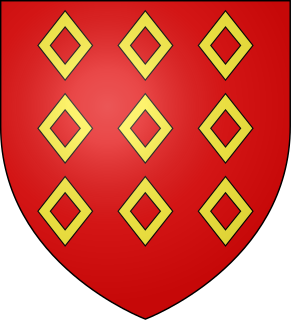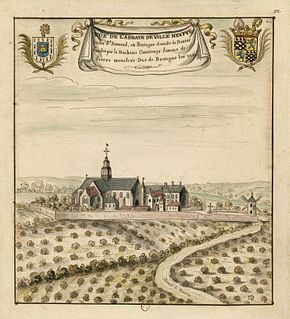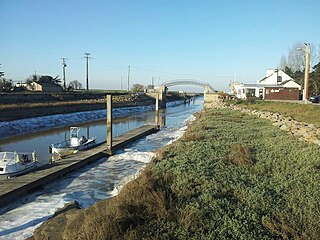
Loire-Atlantique is a department in Pays de la Loire on the west coast of France, named after the river Loire and the Atlantic Ocean. It had a population of 1,429,272 in 2019.

The following is a list of the 207 communes of the Loire-Atlantique department of France.

Peter I, also known as Peter Mauclerc, was Duke of Brittany jure uxoris from 1213 to 1221, and regent of the duchy for his minor son John I from 1221 to 1237. As duke he was also 1st Earl of Richmond from 1218 to 1235.

The House of Rohan is a Breton family of viscounts, later dukes and princes in the French nobility, coming from the locality of Rohan in Brittany. Their line descends from the viscounts of Porhoët and is said to trace back to the legendary Conan Meriadoc. Through the Porhoët, the Rohan are related to the Dukes of Brittany, with whom the family intermingled again after its inception. During the Middle Ages, it was one of the most powerful families in the Duchy of Brittany. They developed ties with the French and English royal houses as well, and played an important role in French and European history.

The arrondissement of Nantes is an arrondissement of France in the Loire-Atlantique department in the Pays de la Loire region. It has 76 communes. Its population is 830,509 (2016), and its area is 1,958.7 km2 (756.3 sq mi).
The following is a list of the 31 cantons of the Loire-Atlantique department, in France, following the French canton reorganisation which came into effect in March 2015:

Machecoul is a former commune in the Loire-Atlantique department in western France. On 1 January 2016, it was merged into the new commune of Machecoul-Saint-Même. Its 5,732 inhabitants are called Machecoulais. It was the site of First Massacre of Machecoul, the opening of the War in the Vendée in 1793.

Abbaretz is a commune in the Loire-Atlantique department in the Pays de la Loire region of western France.

Gétigné is a commune in the department of Loire-Atlantique in the Pays de la Loire region in western France.

The Pays de Retz is a historical subregion of France that currently forms part of the Loire-Atlantique department, but which previously formed part of the Duchy of Brittany.

The Château de Clisson is a castle in the commune of Clisson in the Loire-Atlantique département of France. It stands on the right bank of the Sèvre Nantaise.

Jeanne de Clisson (1300–1359), also known as Jeanne de Belleville and the Lioness of Brittany, was a French / Breton former noblewoman who became a privateer to avenge her husband after he was executed for treason by the French king. She crossed the English Channel targeting French ships and often slaughtering their crew. It was her practice to leave at least one sailor alive to carry her message to the King of France.

Herve I of Léon was the first Lord of Léon, the founding member of the junior branch of the Léon family.

Herve VII of Léon was a Breton lord, son of Herve VI, Lord of Léon and his wife Joanna of Montmorency. Also known as Herve. He succeeded his father as Lord of Léon in 1337. He was also Lord of Noyon-sur-Andelle. The Lords of Léon were a junior branch of the Viscounts of Léon which was founded by Harvey I, second son of Guihomar IV, Viscount of Léon. Herve VII won fame during the War of the Breton Succession.

Villeneuve Abbey, dedicated to Our Lady, was a Cistercian monastery at the present-day Les Sorinières, near Nantes in Pays de la Loire, France, founded in 1201 and dissolved in 1790, during the French Revolution.

The Falleron is a French coastal river forming the boundary between the departments of Vendée and Loire-Atlantique and flowing into the Bay of Biscay and Atlantic Ocean via the Bay of Bourgneuf.

Olivier IV de Clisson (1300–1343), was a Breton Marche Lord and knight who became embroiled in the intrigue of Vannes and was subsequently executed by the King of France for perceived treason. He was the husband of Jeanne de Clisson who eventually became known as the Lioness of Brittany.

Olivier III de Clisson (1280–1320), was a Breton Marche Lord and knight.

Olivier II de Clisson, the Younger, was a Breton frontier lord and son of Olivier I, the Elder of Clisson.















